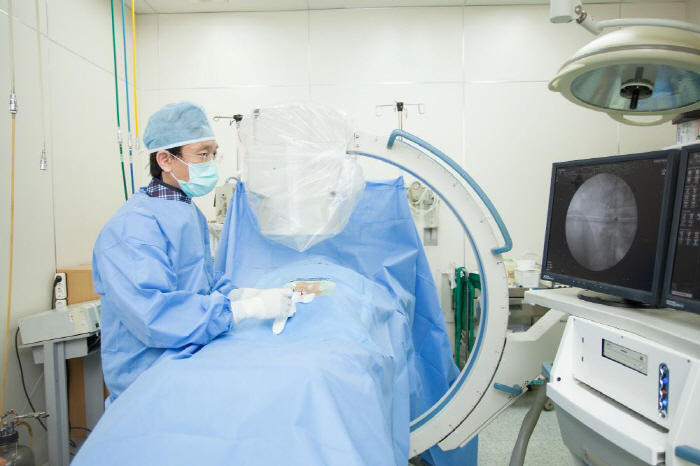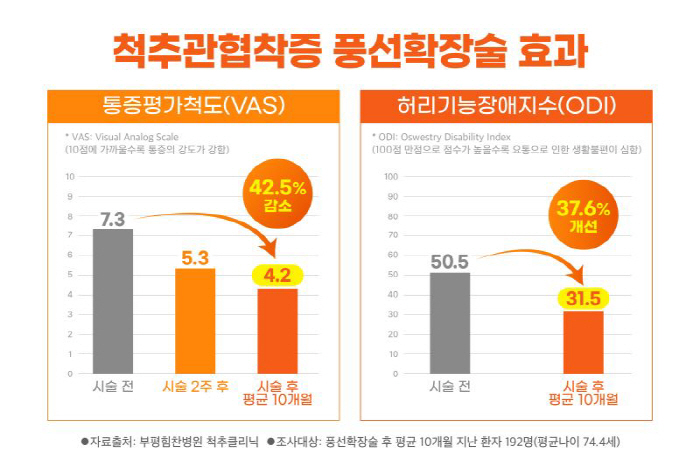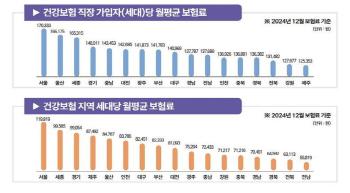Spinal duct stenosis, non-surgical balloon dilatation effect...Bupyeong Himchan Hospital Pain Reduction 42.5% and Function Improvement 37.6%
Apr 01, 2025
|
According to the hospital, 192 patients on average 10 months after balloon dilatation were surveyed, and only three cases underwent surgery. Among them, 67 out of 68 patients who initially considered surgery due to severe adhesion have maintained the improvement effect so far without undergoing surgery after balloon dilatation.
Spinal duct stenosis is a disease that compresses nerves by narrowing the spinal canal, which is the passage through which nerves pass due to degenerative changes such as thickening of ligaments and bones around the spine. When the spinal canal narrows and compresses the nerves, inflammation occurs around the nerves, and over time, the adhesion of fine fibers such as spider webs to each other intensifies, and the degree of pain increases. In addition, since the vicious cycle of worsening inflammation is repeated due to poor blood circulation in the nerve due to adhesion, efficient removal of adhesion is the key to treatment.
Treatment usually includes conservative treatments such as exercise therapy and physical therapy, and non-surgical treatments such as nerve block surgery, neuroplasty, and balloon dilatation first, and if there is no improvement, surgical treatment is considered.
Among non-surgical treatments, nerve block surgery or neuroplasty has limitations in removing severe adhesion.
Neuroblocking is difficult to physically remove the adhesion because it finds the nerve roots that cause pain and injects drugs to relieve pain. In addition, neuroplasty is a procedure in which a small hole is made in the tailbone area, a micro catheter with a diameter of 1mm is inserted, and drugs are injected to remove inflammation and release nerve adhesion.
On the other hand, balloon dilatation puts a balloon at the end of the catheter and inflates it to effectively release adhesion even in areas with severe adhesion and widen the narrowed spinal canal.
Park Jin-kyu (neurosurgery), director of the spinal clinic at Bupyeong Himchan Hospital, said "The balloon can physically peel off the severe adhesion area, so you can expect a greater treatment effect when you put the drug in the damaged area, so you can see the effect of improving symptoms without going to surgery."
In fact, Bupyeong Himchan Hospital surveyed the pain evaluation scale (VAS) of 192 patients who underwent balloon dilatation for spinal canal stenosis, and found that it was 7.3 points before the procedure, 5.3 points after two weeks after the procedure, and 4.2 points after an average of 10 months after the procedure. The pain gradually decreased over time, and the pain decreased by about 42.5% after 10 months compared to before the procedure. The pain evaluation scale (VAS) selects the intensity of pain felt by the patient from 0 to 10, and the intensity of pain increases as it goes to 10.
In addition, as a result of the evaluation of the Owestry Low Back Disability Index (ODI), which checks overall postoperative pain, daily life ability, sleep, and social activities, it improved by about 37.6% from 50.5 points before the procedure to 31.5 points after the procedure. The lumbar dysfunction index is a perfect score of 100, which means that the closer to 100 points, the more severe the dysfunction.
As pain decreased, patients' depression also improved. The degree of depression was found to have eased by about 34.8% from an average of 2.3 points before surgery to an average of 3.1 points after surgery. In addition, by age group, as spinal stenosis is a degenerative disease caused by aging, people in their 60s and older accounted for 76% of all patients, and 18.4% of them were elderly patients in their 80s and older.
Seo Byung-sun (neurosurgeon), director of Bupyeong Himchan Hospital's Spinal Clinic, said "Balloon dilatation is widely applied not only to elderly patients but also to diabetic, hypertension, and osteoporosis patients as there are few aftereffects and damage to normal tissues because the balloon dilatation is performed only on the part where the catheter is inserted. The procedure time is about 20 minutes, and it is usually possible to move immediately after recovery for about 2 hours, so it is less burdensome even for elderly patients. "However, if non-surgical treatment does not improve pain or damage motor nerves, causing paralysis or even difficulty in daily life due to pain or sensory deterioration, it is recommended to consider surgical treatment."
|
This article was translated by Naver AI translator.















